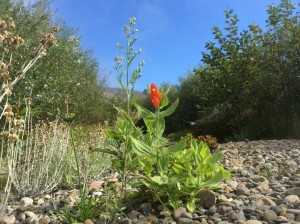We used Mimulus cardinalis (aka Erythranthe cardinalis, Phyrmaceae) as our focal species to test a series of hypotheses regarding geographic range limits. Amy and I received funding through NSF (DEB-0950171) to take a multifaceted approach to understanding what limits the distribution of M. cardinalis. Specifically, we are integrating occupancy surveys, demographic monitoring, and historical inference using population genetic methods to gain a comprehensive understanding of the factors that regulate the distribution of M. cardinalis.
Our research builds on Amy’s previous work in this system, in which she focused on understanding elevational range limits in M. cardinalis and M. lewisii. Using demographic monitoring of populations at the center and margin of these two species’ elevational ranges, Amy found that marginal M. lewisii populations had suppressed population growth rates compared to central populations, while M. cardinalis showed the opposite trend, with the highest population growth rates in marginal (higher elevation) populations (Angert 2006, Angert 2009). In addition, in reciprocal transplant experiments, Amy’s research demonstrated that these species survive and/or reproduce poorly outside of their natural elevational ranges, ruling out dispersal limitation as a viable explanation for their absence beyond their range margins (Angert and Schemske 2005). Growth chamber experiments indicate that adaptation to different temperature regimes plays a pivotal role in restricting the ranges in these species (Angert 2006). Finally, she produced interspecific hybrids of M.lewisii and M. cardinalis, grew them at low and high elevations, mated the survivors at each elevation, and then grew the resulting progeny in a common greenhouse environment. The relative fitness of these two selected hybrid populations were then compared to an unselected control population to look for evidence of adaptive trade-offs. This experiment demonstrated the role of adaptive trade-offs to temperature in restricting the ability of these species to adapt to novel conditions at their range margins (Angert et al. 2008) .
For our current work, we are focusing on M. cardinalis, a wide-ranging species found from the Baja Peninsula in Mexico north to central Oregon, and from the Pacific coast east to the Sierra Nevada Mountains in California (as well as a disjunct population in Arizona). We took what we knew about elevational range limits in M. cardinalis, and investigated if common processes and mechanisms can be invoked to explain general geographic range limits in this species.
In 2008 we conducted extensive surveys to assess presence and absence of populations throughout the Northern two-thirds of the range, focusing on a latitudinal transect from the southern Sierras to central Oregon. Amy’s lab has also established sites for demographic monitoring of populations along this transect, as well as extending towards the southern range limit (mirroring the demography sites that Amy previously established in Yosemite National Park). Over two summers we expanded our occupancy surveys to quantify presence/absence of populations throughout the range based on stratified random points distributed throughout the range and beyond the current range margin.
Our preliminary lab work focused on DNA sequencing a number nuclear introns from populations across the range, with our main focus centered on the Sierra to Oregon transect. The distribution of haplotype frequencies indicate that M. cardinalis shows genetic structure at the scale of major river drainages, with a strong signal of isolation by distance. We are using the sequence data to infer the historical demography of latitudinally central and marginal populations, focusing on the magnitude and directionality of historical gene flow between populations. These analyses will help us determine if the northern latitudinal limit in M. cardinalis is an equilibrial range limit, potentially set by swamping gene flow or metapopulation dynamics (or some combination of these processes). Alternatively, the northern range limit may not be a limit at all, but rather the current extent of an ongoing or recent range expansion. We also used population genomic approaches to help us distinguish these alternatives. We now have high-throughput DNA sequencing data from many loci and many populations, allowing us to draw more rigorous conclusions about range wide population genetic structure.
In the greenhouse and growth chambers, we experimentally quantified the phenotypic differentiation of M. cardinalis populations across the range. We planted seeds from populations on our latitudinal transect and made clones of the individuals. These clones have then been subjected to various temperature regimes in the growth chamber, allowing us to see how replicate genotypes respond to different temperature treatments. These data were used in conjunction with our genetic data to investigate how genetic and phenotypic differentiation are related across the geographic range.







